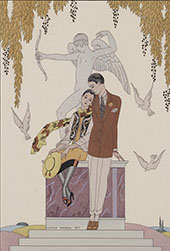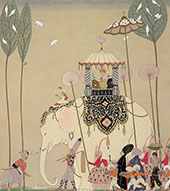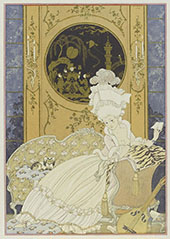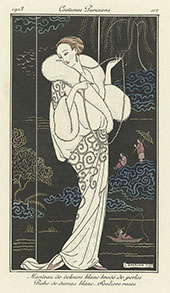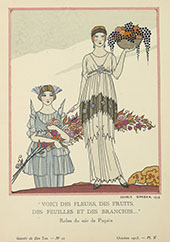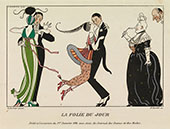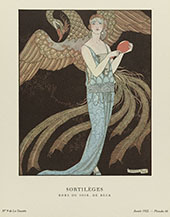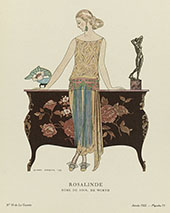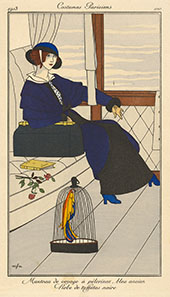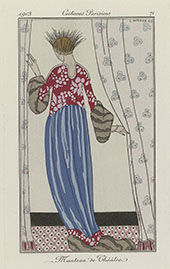George Barbier Oil Painting Reproductions
George Barbier replica paintings on Canvas for sale
Art Deco Artists: George Barbier Biography
Born on 16 October 1882, George Augustin Barbier was a leading pioneer of Art Deco paintings and illustration.
Hailing from Nantes, France, he developed an artistic career at a relatively late age. Indeed, Barbier was 29 years old by the time of his first exhibition. Nonetheless, it was a massive success, and Barbier quickly swept to fame amongst Art Deco artists.
In 1911, Barbier’s first exhibition led to theater and ballet costume design commissions. This early work soon transformed into book illustrations and avant-garde fashion illustrations.
Why is George Barbier well-known?
After 1911, Barbier led an artistic group of illustrators, designers, and artists from the École des Beaux-Arts. As one of France’s most influential art schools, which is particularly associated with the “Beaux-Arts” style of art and architecture. Similar to Art Deco, this style used Renaissance and Baroque detailing but modernized production with contemporary materials such as iron and glass.
Famed for their elegant creations, Barbier’s artistic group quickly rose in prominence. Dubbed by French Vogue as “The Knights of the Bracelet,” the epithet referenced their fashionable dress and flamboyant behavior. Alongside George Barbier, members included Pierre Brissaud, Paul Iribe, Charles Martin (all fellow Art Deco illustrators), Bernard Boutet de Monvel, and Georges Lepape. Monvel and Brissaud were also Barbier’s first cousins.
Barbier’s fashionable and exquisite approach is beautifully apparent with gently colored illustrations such as A Woman Reading a Letter and White Velvet Coat Embroidered with Pearls. As shown in these drawings, many Art Deco paintings (Barbier no exception) took strong inspiration from Japanese tradition. Revised and updated for 1920s French fashions and tastes, however, a new Franco-Japanese aesthetic appeared.
What did George Barbier design?
In addition to Art Deco illustration, George Barbier also designed wallpaper, decorative glassware, and jewelry during his career. Furthermore, he authored articles and sent illustrations for the Gazette du Bon Ton, Journal des Dames (Art Modes et Frivolites), a highly influential and respected Fashion magazine. The name translates as Journal of Good Taste or Journal of Good Style.
Published from 1912 to 1925, the magazine reflected the latest developments in fashion and beauty during this elegant period of French society and culture.
One notable example of a Barbier Gazette du Bon Ton illustration is La Fontaine de Coquillages. Published in March 1914, it depicts a “robe du soir de paquin,” which translates as a Paquin evening dress. The esteemed couture house of Paquin opened in February 1891, with Jeanne Paquin retiring in 1920.
Was George Barbier well-known?
From the mid-1920s onwards, Barbier worked with Erté (ne Romain de Tirtoff), the legendary set designer, jeweler, and costumier. Together, their reputation skyrocketed, and the pair were incredibly well-known.
The men designed both costumes and sets for the Folies Bergère (famously painted by Edouard Manet). They enjoyed a productive working relationship, and nine years later, Barbier penned the introduction to an acclaimed Erté exhibition.
By this point, Barbier was also increasing in fame and renown and quickly becoming a household name in fashionable Parisian society. In addition, Barbier's frequent features in L’Illustration magazine, the first ever international illustrated paper, drew attention to his work. Indeed, the magazine (and Barbier’s illustrations) circulated in over 150 countries.
One of his later illustrations, La Belle Dame Sans Merci (translating as The Beautiful Lady Without Mercy), represents Barbier’s increasing confidence. As a Ballad written by John Keats in 1891, the title derived from a 15th-century poem by the French poet and political writer Alain Chartier.
As a fairy story condemning a Knight to an unpleasant fate with her beautiful eyes and song, it was a particular favorite amongst artists and poets. Indeed, Barbier’s illustration sits amongst the rich femme fatale tradition. Nonetheless, his Art Deco detailing (including geometric architectural details contrasting with the opulent avian plumage) brought the tale into the decadent world of the 1920s
When did George Barbier die?
George Barbier died on 16 March 1932. At just 49 years old, this sadly cut his illustrious career prematurely short. Buried at the Cemetery Miséricorde, he’s still in his hometown of Nantes on France’s Atlantic coast.
Given that George Barbier is primarily known for his Art Deco illustration, it is worth taking a closer look at precisely what inspired these beautiful creations.
What is Art Deco in decoration?
Standing for “Arts Décoratifs,” Art Deco décor was immensely popular from the 1920s to the 1940s. Today, it still brings luxury and glamor to interior and exterior spaces. Characterized by bold geometric shapes, decadent detailing, and rich coloring, it exudes elegance and opulence.
Art Deco décor emphasizes symmetrical designs and exuberant shapes, bringing classic 1920s style into decorative schemes. In practical terms, this often involves angular, streamlined shapes (for instance, bold armchairs and lamps) contrasting with symmetrically placed mirrors, sunburst designs, polished woods, and flowing fabrics.
Even small Art Deco accents (for instance, vases or side tables) bring a feel of this beautiful movement into decorative schemes. Of course, one excellent way to incorporate Art Deco glamor into your home is through prints and fine art oil paintings from George Barbier, Coles Phillips, and Tamara de Lempicka.
What colors appear in Art Deco designs?
Art Deco paintings and interior designers use a wide array of colors. Specific tones weren’t as crucial as a jewel-like opulent finish. However, they often combine with luminous golds and silvers.
Despite this, favorite color combinations of the era included:
Bright, deep yellows, greens, blues, reds, and pinks. The contrast between vivid reds, pinks, and blues exemplifies George Barbier illustrations, such as L’oiseau Volage (1914).
Softer background colors like creams and beiges often blend with incredibly pale blues and pastels. This approach is visible in George Barbier’s Au Revoir illustration, where fashionable party guests wave goodbye to departing revelers. The pale blue walls, dresses, and cars contrast with the beige-yellow glow of the ballroom behind.
Is Art Deco still popular today?
Art Deco décor is still massively popular today. It remains a staple of interior design, seen in furniture, architecture, textiles, wallpaper, jewelry, mirrors, and lighting fixtures.
Indeed, the style is so prevalent and well-known that many people don’t realize how much Art Deco décor is around. So the chances are that most of us have Art Deco-inspired pieces already sitting in our homes.
What’s more, however, design trends experts predict an explosion of Art Deco detailing in the next few years. Its futuristic and historical influences, pared-back geometric detailing, and a mixture of cool colors with “pops” of opulent jewel-toned hues perfectly suit the modern 21st-century aesthetic. Of course, we’re now well into the 2020s, and what time could be better for a return to the roaring 1920s?
Art Deco Art: Museum Quality Oil Paintings on Canvas
Explore our unrivaled collection of Art Deco paintings if you love George Barbier and his beautiful Art Deco illustration. You’ll find stunning hand-crafted artworks to enrich your life and your walls with a wide selection of museum-quality oil paintings on canvas.
Testimonial from Miquel G, Artesia, New Mexico, USA
Cannot Find What You Are Looking For?
Reproduction Gallery Information
Customer Service
(Send Us A Message)
Tel: (503) 937 2010
Fax: (503) 937 2011




